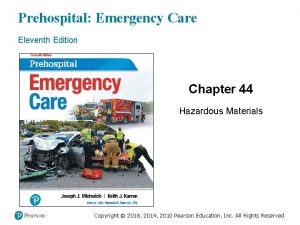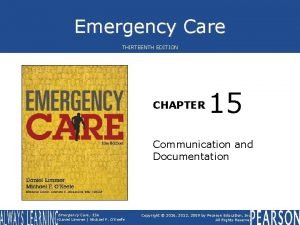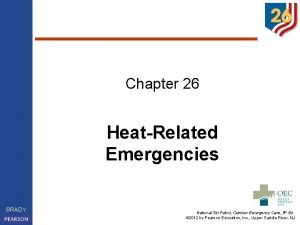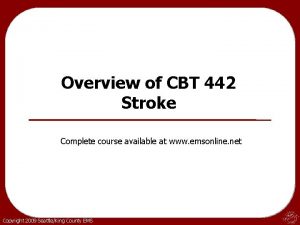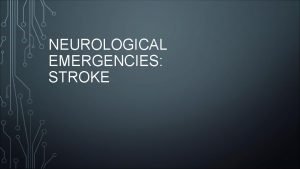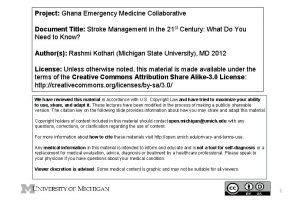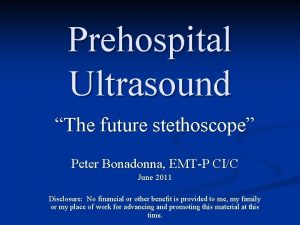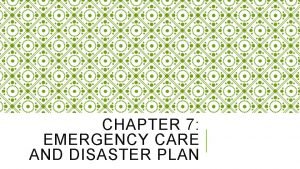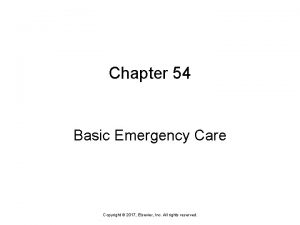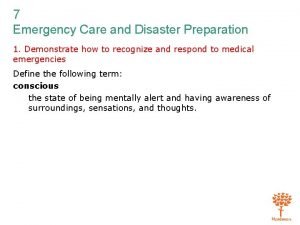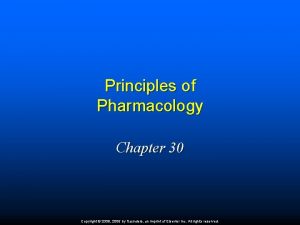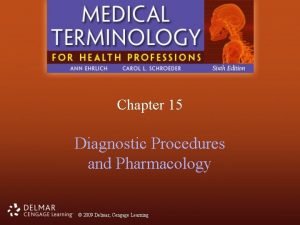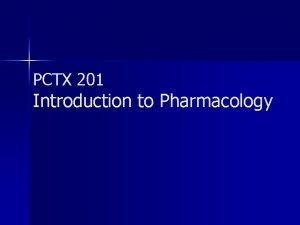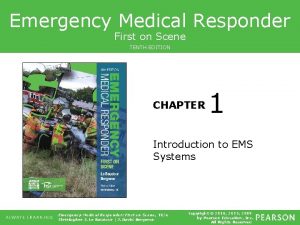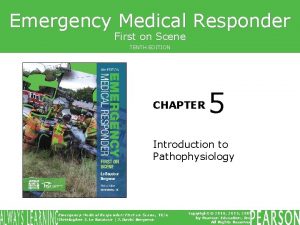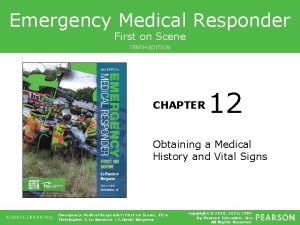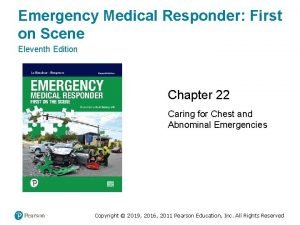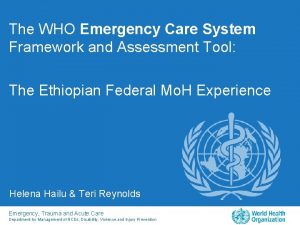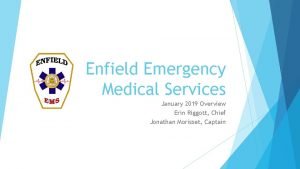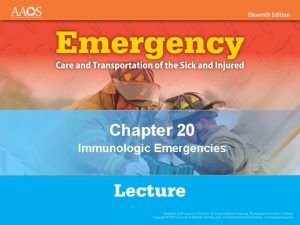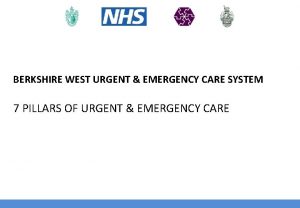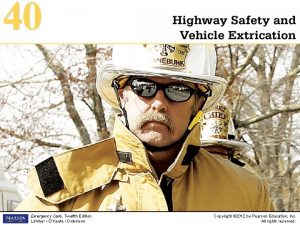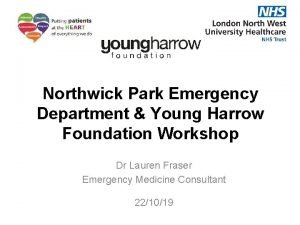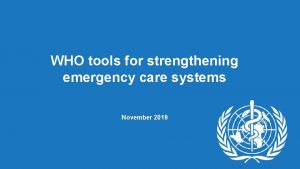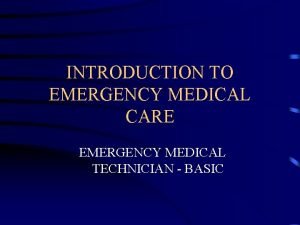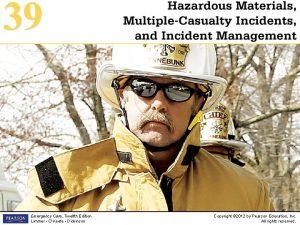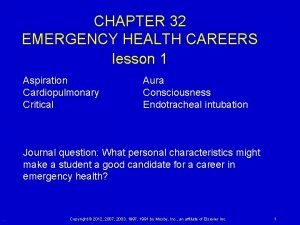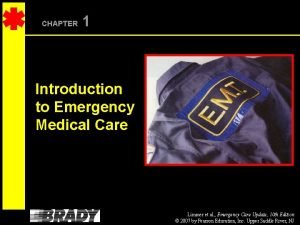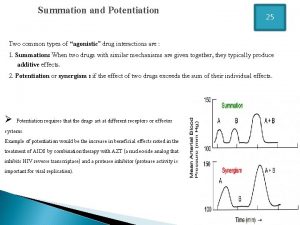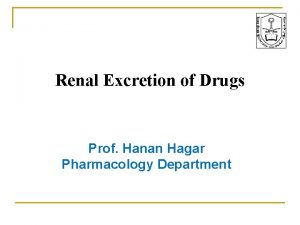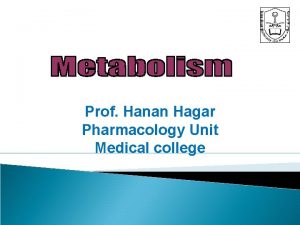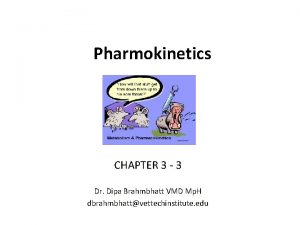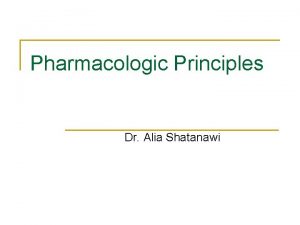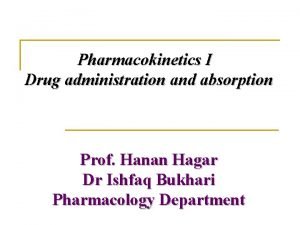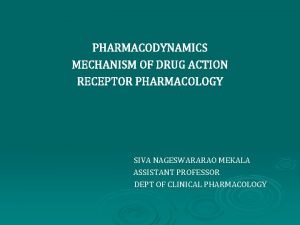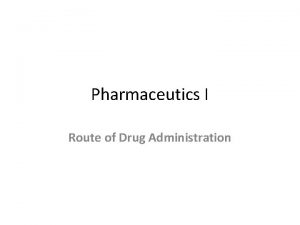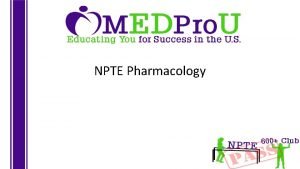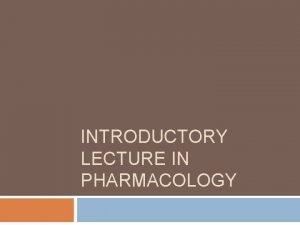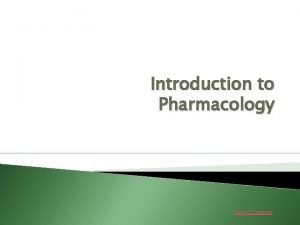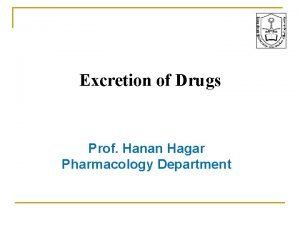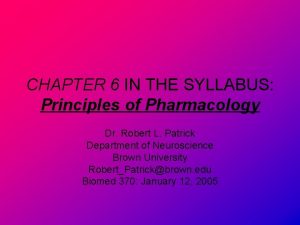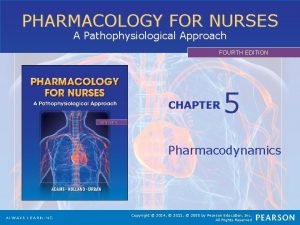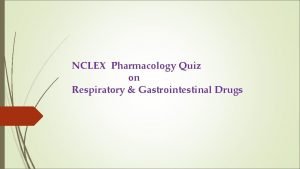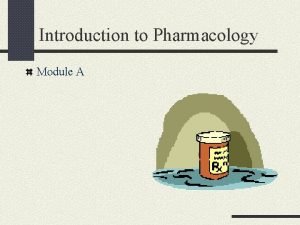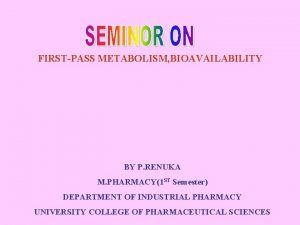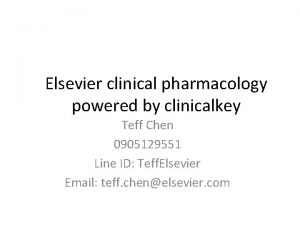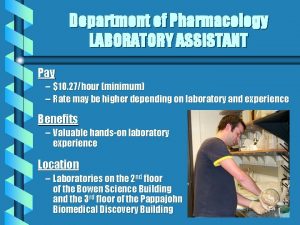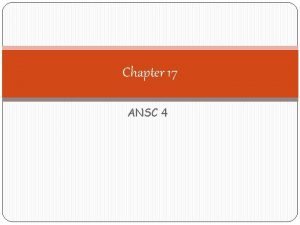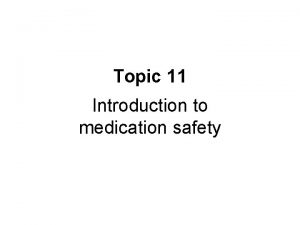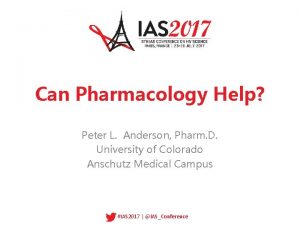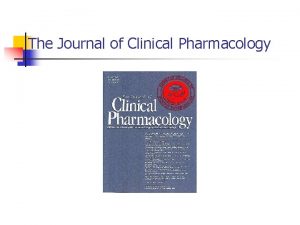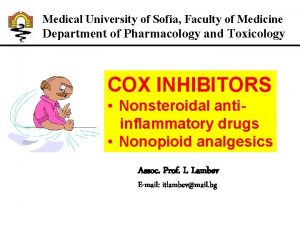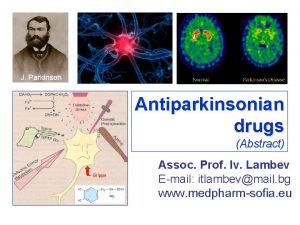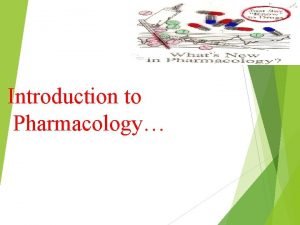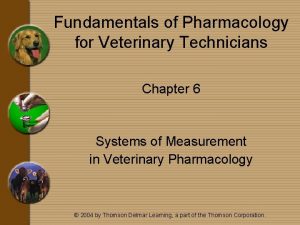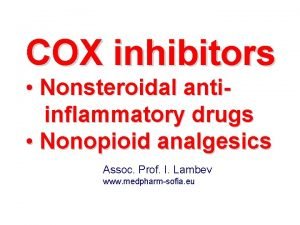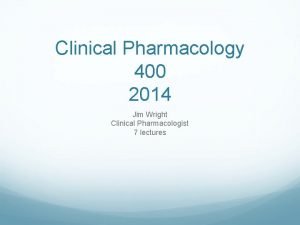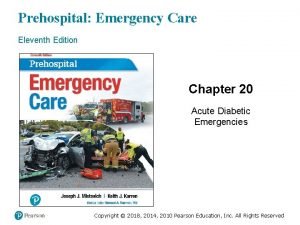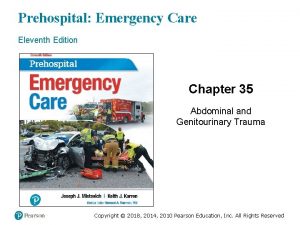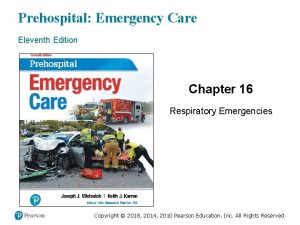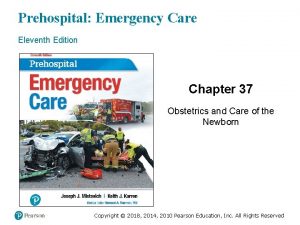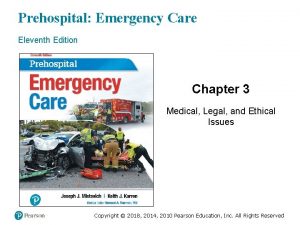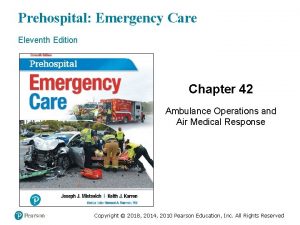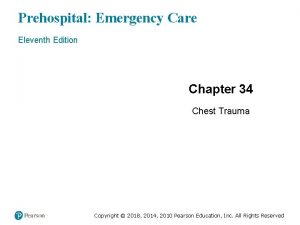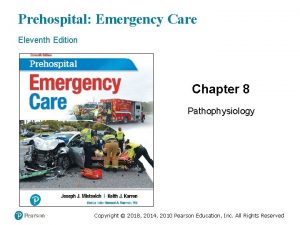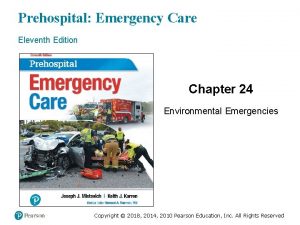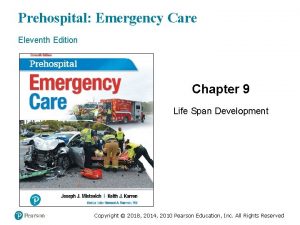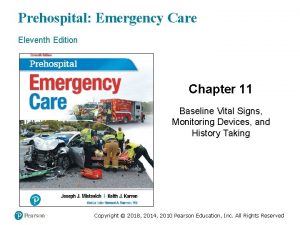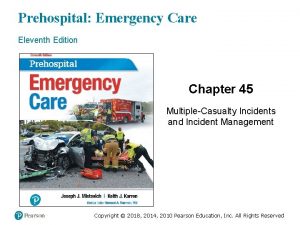Prehospital Emergency Care Eleventh Edition Chapter 14 Pharmacology


















































































- Slides: 82

Prehospital: Emergency Care Eleventh Edition Chapter 14 Pharmacology and Medication Administration Slides in this presentation contain hyperlinks. JAWS users should be able to get a list of links by using INSERT+F 7 Copyright © 2018, 2014, 2010 Pearson Education, Inc. All Rights Reserved

Learning Readiness • EMS Education Standards, text p. 419. • Chapter Objectives, text p. 419. • Key Terms, text p. 419. • Purpose of lecture presentation versus textbook reading assignments. Copyright © 2018, 2014, 2010 Pearson Education, Inc. All Rights Reserved

Setting the Stage (1 of 2) • Overview of Lesson Topics – Administering Medications – Medications the EMT Commonly Administers – Medication Names – Routes of Administration – Medication Forms Copyright © 2018, 2014, 2010 Pearson Education, Inc. All Rights Reserved

Setting the Stage (2 of 2) • Overview of Lesson Topics – Essential Medication Information – Key Steps in Administering Medications – Reassessment Following Administration – Sources of Medication Information Copyright © 2018, 2014, 2010 Pearson Education, Inc. All Rights Reserved

Case Study Introduction (1 of 2) As EMT Nate Quick approaches the patient, he sees that the patient, who is sitting on the ground, leaning forward to support himself with his hands, is in respiratory distress. The patient, a teenage boy, does not acknowledge his presence, and appears pale and sweaty. Copyright © 2018, 2014, 2010 Pearson Education, Inc. All Rights Reserved

Case Study Introduction (2 of 2) “Hurry!” exclaims the woman kneeling next to the boy. “He is allergic to bees. He was stung by a wasp! I don’t know how to use his epinephrine injector. ” Copyright © 2018, 2014, 2010 Pearson Education, Inc. All Rights Reserved

Case Study (1 of 3) • What is your initial impression of how serious the patient’s condition is? • How is epinephrine beneficial to a patient with a serious allergic reaction? • What would you need to know about epinephrine before administering it? Copyright © 2018, 2014, 2010 Pearson Education, Inc. All Rights Reserved

Introduction • EMTs administer or assist in the administration of medications. • You must be completely familiar with medications and the proper procedures for giving them. • Medications are administered under medical direction. Copyright © 2018, 2014, 2010 Pearson Education, Inc. All Rights Reserved

Administering Medications (1 of 3) • A drug, or medication, is a chemical that is used to treat or prevent a disease or condition. • The study of drugs is called pharmacology. • With EMT medication administration, it is common for the medications to be carried on the EMS unit. Copyright © 2018, 2014, 2010 Pearson Education, Inc. All Rights Reserved

Administering Medications (2 of 3) • Medications have specific effects on the body. • When administered correctly, the patient's condition may improve significantly. • When administered inappropriately, drugs can cause serious side effects. Copyright © 2018, 2014, 2010 Pearson Education, Inc. All Rights Reserved

Administering Medications (3 of 3) • EMTs only administer or assist with drugs listed in their protocols with medical direction approval. Copyright © 2018, 2014, 2010 Pearson Education, Inc. All Rights Reserved

Medications the EMT Commonly Administers (1 of 12) • Medications the EMT administers are either carried on the EMS unit or are prescribed for the patient. • Do not let the patient attempt to get their medication, because the activity may increase their discomfort and aggravate the medical condition. • Become completely familiar with your local protocol. Copyright © 2018, 2014, 2010 Pearson Education, Inc. All Rights Reserved

Medications the EMT Commonly Administers (2 of 12) • Medications – Oxygen: A medical gas that is indicated when: ▪ You suspect hypoxia, hypoxemia. ▪ The patient complains of dyspnea or is in respiratory distress. ▪ The patient has signs of shock or poor perfusion. ▪ The Sp. O 2 is less than 94%. Copyright © 2018, 2014, 2010 Pearson Education, Inc. All Rights Reserved

Medications the EMT Commonly Administers (3 of 12) • Medications – Oxygen: Precautions with Oxygen Administration ▪ High concentrations of oxygen have been found to reduces systemic coronary artery blood flow. ▪ High concentrations of oxygen have been found to increase tissue damaging free radical production. Copyright © 2018, 2014, 2010 Pearson Education, Inc. All Rights Reserved

Medications the EMT Commonly Administers (4 of 12) 3 • Medications – Oxygen: Oxygen Administration Difference in Medical vs. Trauma Patients ▪ Medical conditions should be supplemented to an Sp. O 2 of 94 percent. ▪ Trauma should be supplemented to an Sp. O 2 of 95 percent. Copyright © 2018, 2014, 2010 Pearson Education, Inc. All Rights Reserved

Medications the EMT Commonly Administers (5 of 12) • Medications – Oral glucose ▪ Brain cells require an uninterrupted supply of glucose. ▪ Oral glucose may be administered to diabetics with low blood glucose levels. Copyright © 2018, 2014, 2010 Pearson Education, Inc. All Rights Reserved

Medications the EMT Commonly Administers (6 of 12) • Medications – Activated charcoal ▪ A fine black powder ▪ May be administered in some cases of ingested poisoning to absorb the poison and prevent its absorption into the body Copyright © 2018, 2014, 2010 Pearson Education, Inc. All Rights Reserved

Medications the EMT Commonly Administers (7 of 12) • Medications – Aspirin ▪ Administered to patients with chest discomfort or pain related to a lack of oxygen supplied to the heart ▪ May prevent complete blockage of coronary arteries by interfering with platelet function Copyright © 2018, 2014, 2010 Pearson Education, Inc. All Rights Reserved

Medications the EMT Commonly Administers (8 of 12) • Medications – Inhaled bronchodilators: Metered Dose Inhaler ▪ Prescribed to patients with chronic respiratory disease ▪ EMTs may only administer medications that are beta 2 agonists, designed to dilate the bronchioles ▪ Drugs include albuterol and levalbuterol Copyright © 2018, 2014, 2010 Pearson Education, Inc. All Rights Reserved

Medications the EMT Commonly Administers (9 of 12) • Medications – Inhaled bronchodilators: Small-Volume Nebulizer ▪ Prescribed to patients with chronic respiratory disease ▪ EMTs may only administer medications that are beta 2 agonists, designed to dilate the bronchioles ▪ Drugs include albuterol and levalbuterol Copyright © 2018, 2014, 2010 Pearson Education, Inc. All Rights Reserved

Medications the EMT Commonly Administers (10 of 12) • Medications – Nitroglycerin ▪ Used by cardiac patients ▪ Dilates blood vessels to reduce workload of the heart and allow increased blood flow to the heart muscle ▪ Hypotension is a major side effect ▪ Must not be given to patients who have recently taken drugs for erectile dysfunction Copyright © 2018, 2014, 2010 Pearson Education, Inc. All Rights Reserved

Medications the EMT Commonly Administers (11 of 12) • Medications – Epinephrine ▪ Used to treat severe allergic reactions (anaphylaxis) ▪ Reverses vasodilation, bronchoconstriction, and increased capillary permeability through actions on the sympathetic nervous system ▪ Patients with severe allergies may carry an epinephrine autoinjector. Copyright © 2018, 2014, 2010 Pearson Education, Inc. All Rights Reserved

Medications the EMT Commonly Administers (12 of 12) • Medications – Naloxone Hydrochloride (also known as Narcan) ▪ Used to treat a known or suspected opioid overdose ▪ Naloxone is a competitive opioid antagonist that competes for the same receptor binding sites as the opioid drug ▪ Narcan suddenly reverses respiratory depression, hypotension, and sedative effects created by the opioid overdose Copyright © 2018, 2014, 2010 Pearson Education, Inc. All Rights Reserved

Case Study (2 of 3) Kneeling next to the patient, Nate can hear stridor and wheezing, and he detects a weak, rapid radial pulse. The patient is unable to speak. With the history of bee sting allergy, a witnessed bee sting, and signs of severe distress associated with anaphylaxis, Nate knows he must act quickly. Following protocol, Nate prepares to administer the epinephrine autoinjector. Copyright © 2018, 2014, 2010 Pearson Education, Inc. All Rights Reserved

Case Study (3 of 3) • What is the medication form that Nate is about to administer? • By what route will Nate administer the medication? • What are the steps that Nate must follow in administering the medication? Copyright © 2018, 2014, 2010 Pearson Education, Inc. All Rights Reserved

Medication Names (1 of 2) • Drugs have the following categories of names: – Chemical – Generic – Trade – Official Copyright © 2018, 2014, 2010 Pearson Education, Inc. All Rights Reserved

Medication Names (2 of 2) • Example: – Chemical Name: 1, 2, 3 -propanetriol trinitrate – Generic Name: nitroglycerin tablets – Official Name: nitroglycerin tablets, U. S. P. – Trade Name: Nitrostat Copyright © 2018, 2014, 2010 Pearson Education, Inc. All Rights Reserved

Table 14 -1 Common Generic and Trade Medication Names (1 of 2) Generic Name Trade Name(s) Used for Oxygen None Hypoxia, hypoxemia, poor perfusion, shock, respiratory distress, dyspnea, heart failure, altered mental status, Sp. O 2 < 94%, or an unknown oxygen saturation reading Glucose, oral Glutose, Insta-Glucose Altered mental status associated with hypoglycemia Activated charcoal Super. Char, Insta. Char, Actidose, Liqui. Char Ingestion poisoning emergencies Nitroglycerin Nitrostat (tablet) Chest pain of cardiac origin Nitroglycerin spray Nitrolingual Spray Blank Copyright © 2018, 2014, 2010 Pearson Education, Inc. All Rights Reserved

Table 14 -1 Common Generic and Trade Medication Names (2 of 2) Generic Name Trade Name(s) Used for Epinephrine Adrenalin Epi. Pen, Auvi-Q auto-injectors Anaphylactic reaction Albuterol Proventil, Ventolin, Pro. Air, Accu. Neb, Vo. Spire Breathing difficulty associated with respiratory condition and Bronchoconstriction Levalbuterol Xopenex Blank Ipratropium Bromide/ Albutero Combivent, Duo. Neb Blank Aspirin Bayer aspirin, Easprin, Ecotrin, Empirin, Ascriptin, Bufferin, Buffex Patient experiencing chest pain or chest discomfort suggestive of an acute coronary syndrome Naloxone Hydrochloride Narcan, Narcan Nasal Spray, EVZIO Known or suspected opioid overdose Copyright © 2018, 2014, 2010 Pearson Education, Inc. All Rights Reserved

Routes of Administration (1 of 8) • The route is how the medication is given to or taken by the patient. • The route affects how fast the medication is absorbed by the body and its effect. • Each medication EMT administers is prepared in a form that allows for the quickest and safest absorption into the body. Copyright © 2018, 2014, 2010 Pearson Education, Inc. All Rights Reserved

Routes of Administration (2 of 8) • EMTs commonly give medications by these routes: – Sublingual – Oral – Inhalation – Intramuscular injection – Intranasal – Subcutaneous Copyright © 2018, 2014, 2010 Pearson Education, Inc. All Rights Reserved

Routes of Administration (3 of 8) • Sublingual – Medication is placed beneath the patient’s tongue, where it is dissolved and absorbed – Used only in alert patients – Used to administer nitroglycerin tablets and spray Copyright © 2018, 2014, 2010 Pearson Education, Inc. All Rights Reserved

Routes of Administration (4 of 8) • Oral – The drug is swallowed for absorption through the gastrointestinal tract (activated charcoal is not absorbed) – Used only in alert patients – Used to administer aspirin, oral glucose, activated charcoal Copyright © 2018, 2014, 2010 Pearson Education, Inc. All Rights Reserved

Routes of Administration (5 of 8) • Inhalation – Used for gases and aerosols – Medication is inhaled into the lungs for absorption – Used to administer oxygen and medications given by metered-dose inhaler or small-volume nebulizer Copyright © 2018, 2014, 2010 Pearson Education, Inc. All Rights Reserved

Routes of Administration (6 of 8) • Intramuscular injection – Injected into a muscle mass for absorption – Requires use of a needle – Some discomfort to patient – Used to administer epinephrine by autoinjector Copyright © 2018, 2014, 2010 Pearson Education, Inc. All Rights Reserved

Routes of Administration (7 of 8) • Intranasal – The medication is sprayed into one or both nostrils – The MAD creates a fine spray of drug particles of a specific size that stick to the mucosal lining – The medication cannot be absorbed without an MAD Copyright © 2018, 2014, 2010 Pearson Education, Inc. All Rights Reserved

Routes of Administration (8 of 8) • Subcutaneous – The medication is injected under the skin into the subcutaneous layer – Produce a slower absorption rate than intramuscular injections – Can be used after an IM injection of Narcan to prolong the desired effect Copyright © 2018, 2014, 2010 Pearson Education, Inc. All Rights Reserved

Medication Forms (1 of 8) • The form usually limits administration to one specific route. • Common forms include: – Compressed powder or tablet Copyright © 2018, 2014, 2010 Pearson Education, Inc. All Rights Reserved

Aspirin, in Pill Form, May Be Administered for Chest Pain When a Heart Attack Is Suspected Copyright © 2018, 2014, 2010 Pearson Education, Inc. All Rights Reserved

Medication Forms (2 of 8) • Common forms include: – Liquid for injection ▪ A liquid substance with no particulate matter Copyright © 2018, 2014, 2010 Pearson Education, Inc. All Rights Reserved

The Epinephrine Auto-Injector May Be Prescribed for Patients with a History of Severe Allergic or Anaphylactic Reaction The Epi. Pen is a brand of epinephrine auto-injector. Copyright © 2018, 2014, 2010 Pearson Education, Inc. All Rights Reserved

Medication Forms (3 of 8) • Common forms include: – Gel Copyright © 2018, 2014, 2010 Pearson Education, Inc. All Rights Reserved

Oral Glucose is a Viscous Gel Used in Acute Diabetic Emergencies. It is Carried on the EMS Unit Copyright © 2018, 2014, 2010 Pearson Education, Inc. All Rights Reserved

Medication Forms (4 of 8) • Common forms include: – Suspension ▪ Mixtures do not remain mixed Copyright © 2018, 2014, 2010 Pearson Education, Inc. All Rights Reserved

Activated Charcoal is Administered in Suspension Form and is Carried on Some EMS Units. It May Be Used in Poisoning and Overdose Emergencies Copyright © 2018, 2014, 2010 Pearson Education, Inc. All Rights Reserved

Medication Forms (5 of 8) • Common forms include: – Fine powder for inhalation – Delivered by metered dose inhaler Copyright © 2018, 2014, 2010 Pearson Education, Inc. All Rights Reserved

A Metered-Dose Inhaler or a Metered-Dose Inhaler with a Spacer May Be Prescribed for Respiratory Conditions Copyright © 2018, 2014, 2010 Pearson Education, Inc. All Rights Reserved

Medication Forms (6 of 8) • Common forms include: – Small-volume nebulizer ▪ Uses a compressed gas to form an aerosol in a mixing chamber ▪ The aerosol is inhaled by the patient through a mouthpiece or a face mask Copyright © 2018, 2014, 2010 Pearson Education, Inc. All Rights Reserved

Nebulized Medications May Be Administered by a Small-Volume Nebulizer, Through Either a Mouthpiece or a Face Mask (© Carl Leet, YSU) Copyright © 2018, 2014, 2010 Pearson Education, Inc. All Rights Reserved

Medication Forms (7 of 8) • Common forms include: – Gas Copyright © 2018, 2014, 2010 Pearson Education, Inc. All Rights Reserved

The Gas Oxygen is Considered a Medication It is the most commonly used medication in EMS and is carried on the EMS unit. Copyright © 2018, 2014, 2010 Pearson Education, Inc. All Rights Reserved

Medication Forms (8 of 8) • Common forms include: – Spray ▪ Droplets can be deposited under the tongue Copyright © 2018, 2014, 2010 Pearson Education, Inc. All Rights Reserved

The EMT May Assist the Patient with Administration of Nitroglycerin Prescribed for Chest Pain Two Common Forms Are Tablet and Spray. Copyright © 2018, 2014, 2010 Pearson Education, Inc. All Rights Reserved

Essential Medication Information (1 of 7) • For each medication, you must understand the following information: – Indications – Contraindications – Dose – Administration – Actions – Side effects Copyright © 2018, 2014, 2010 Pearson Education, Inc. All Rights Reserved

Essential Medication Information (2 of 7) • Indications – The most common uses of the drug in treating a specific condition – Geared toward relief of signs, symptoms, or specific conditions Copyright © 2018, 2014, 2010 Pearson Education, Inc. All Rights Reserved

Essential Medication Information (3 of 7) • Contraindications – Situations in which the drug should not be administered because of the harm it could cause Copyright © 2018, 2014, 2010 Pearson Education, Inc. All Rights Reserved

Essential Medication Information (4 of 7) • Dose – The amount of the drug that is given to the patient Copyright © 2018, 2014, 2010 Pearson Education, Inc. All Rights Reserved

Essential Medication Information (5 of 7) • Administration – The route by which the medication is given to the patient Copyright © 2018, 2014, 2010 Pearson Education, Inc. All Rights Reserved

Essential Medication Information (6 of 7) • Actions – The effect the drug has on the body ▪ The therapeutic effect is the intended positive response by the body. ▪ The mechanism of action is how the drug works to create its effect on the body. Copyright © 2018, 2014, 2010 Pearson Education, Inc. All Rights Reserved

Essential Medication Information (7 of 7) • Side Effects – Actions that are not desired and that occur in addition to the desired therapeutic effects – May be predictable or unpredictable Copyright © 2018, 2014, 2010 Pearson Education, Inc. All Rights Reserved

Click on the Term That is Used to Describe Reasons Why a Medication Must Not Be Given to a Patient A. Side effects B. Indications C. Actions D. Contraindications Copyright © 2018, 2014, 2010 Pearson Education, Inc. All Rights Reserved

Key Steps in Administering Medication (1 of 10) • Follow these steps in administering medication: – Obtain an order from medical direction. – Select the proper medication. – Verify the patient’s prescription. – Check the expiration date. Copyright © 2018, 2014, 2010 Pearson Education, Inc. All Rights Reserved

Key Steps in Administering Medication (2 of 10) • Follow these steps in administering medication: – Check for discoloration or impurities. – Verify the form, route, and dose. – Check the Five Rights of medication administration. – Document medication administration. Copyright © 2018, 2014, 2010 Pearson Education, Inc. All Rights Reserved

Key Steps in Administering Medication (3 of 10) • Obtain an Order from Medical Direction – Every medication EMTs administer or assist with requires an order from medical direction. – The order may be obtained on-line or off-line. – Verify an on-line order by restating it. Copyright © 2018, 2014, 2010 Pearson Education, Inc. All Rights Reserved

Key Steps in Administering Medication (4 of 10) • Select the Proper Medication – Read the label carefully. – Many medications have several trade names. Copyright © 2018, 2014, 2010 Pearson Education, Inc. All Rights Reserved

Key Steps in Administering Medication (5 of 10) • Verify the Patient’s Prescription for Patient-Assisted Administration – When assisting with the patient’s medication, verify that the medication to be given is prescribed to them. Copyright © 2018, 2014, 2010 Pearson Education, Inc. All Rights Reserved

Key Steps in Administering Medication (6 of 10) • Check the Expiration Date – Do not administer expired medications. Copyright © 2018, 2014, 2010 Pearson Education, Inc. All Rights Reserved

Key Steps in Administering Medication (7 of 10) • Check for Discoloration or Impurities – Inspect for discoloration and cloudiness. – Do not give discolored or cloudy medications. Copyright © 2018, 2014, 2010 Pearson Education, Inc. All Rights Reserved

Key Steps in Administering Medication (8 of 10) • Verify the Form, Route, and Dose – Use the proper form for the route selected. – Make sure the label matches the order from medical direction. Copyright © 2018, 2014, 2010 Pearson Education, Inc. All Rights Reserved

Key Steps in Administering Medication (9 of 10) • Medication Administration: The Five “Rights” 1. 2. 3. 4. 5. Right patient Right medication Right route Right dose Right time Copyright © 2018, 2014, 2010 Pearson Education, Inc. All Rights Reserved

Key Steps in Administering Medication (10 of 10) • Documentation – Drug – Dose – Route – Time – Changes in patient’s condition Copyright © 2018, 2014, 2010 Pearson Education, Inc. All Rights Reserved

Reassessment Following Administration (1 of 2) • You must reassess the patient after medication administration for: – Mental status – Airway – Respirations – Pulse – Skin – Blood pressure Copyright © 2018, 2014, 2010 Pearson Education, Inc. All Rights Reserved

Reassessment Following Administration (2 of 2) • You must reassess the patient after medication administration for: – S p O 2 – Change in complaints/relief of signs and symptoms – Medication side effects – Change in patient’s condition Copyright © 2018, 2014, 2010 Pearson Education, Inc. All Rights Reserved

Sources of Medication Information • American Hospital Formulary Service • AMA Drug Evaluation • Physicians’ Desk Reference (PDR) • Package inserts • Poison control centers • EMS pocket drug reference guide • e. Pocrates • Other medical director approved web sites Copyright © 2018, 2014, 2010 Pearson Education, Inc. All Rights Reserved

Case Study Conclusion (1 of 2) As Nate’s partner assists the patient’s ventilations, Nate mentally reviews the protocol for anaphylaxis, which allows him to administer a patient’s epinephrine pen in such circumstances. He confirms that the medication belongs to the patient, and checks the name, dosage, and expiration date. Copyright © 2018, 2014, 2010 Pearson Education, Inc. All Rights Reserved

Case Study Conclusion (2 of 2) He administers the drug by the intramuscular route, and prepares to repeat the primary assessment and perform a secondary assessment. Fortunately, the epinephrine begins working quickly, but Nate knows that its effects are shortlived, and that they must work quickly to get the patient to the hospital. Copyright © 2018, 2014, 2010 Pearson Education, Inc. All Rights Reserved

Summary • Medication administration is a considerable responsibility. • EMTs give medications only under medical direction. • You must understand the indications, contraindications, dose, administration route and form, actions, and side effects. • Always utilize the Five Rights of Medication Administration. Copyright © 2018, 2014, 2010 Pearson Education, Inc. All Rights Reserved

Correct! Contraindications are reasons that you would not administer a medication to a patient, because of the harm that could be done. Click here to return to the program. Copyright © 2018, 2014, 2010 Pearson Education, Inc. All Rights Reserved

Incorrect (1 of 3) Side effects are the unintended effects of a drug that is given, which may either be predictable or unpredictable. Click here to return to the quiz. Copyright © 2018, 2014, 2010 Pearson Education, Inc. All Rights Reserved

Incorrect (2 of 3) Indications are reasons why the drug would be given in the treatment of a disease or condition. Click here to return to the quiz. Copyright © 2018, 2014, 2010 Pearson Education, Inc. All Rights Reserved

Incorrect (3 of 3) Actions are the way in which a drug has a therapeutic effect on the body. Click here to return to the quiz. Copyright © 2018, 2014, 2010 Pearson Education, Inc. All Rights Reserved

Copyright © 2018, 2014, 2010 Pearson Education, Inc. All Rights Reserved
 Prehospital emergency care 11th edition
Prehospital emergency care 11th edition Prehospital emergency care 10th edition
Prehospital emergency care 10th edition Pre-hospital communication
Pre-hospital communication Prehospital emergency care 11th edition study guide
Prehospital emergency care 11th edition study guide Prehospital emergency care 11th edition
Prehospital emergency care 11th edition Prehospital emergency care 11th edition
Prehospital emergency care 11th edition Management eleventh edition
Management eleventh edition Management eleventh edition stephen p robbins
Management eleventh edition stephen p robbins Management eleventh edition
Management eleventh edition Management eleventh edition stephen p robbins
Management eleventh edition stephen p robbins Emergency care 13th edition chapter 1
Emergency care 13th edition chapter 1 Outdoor emergency care 6th edition
Outdoor emergency care 6th edition Chadha committee
Chadha committee Eleventh 5 year plan
Eleventh 5 year plan 11th five year plan
11th five year plan For his eleventh birthday elvis presley
For his eleventh birthday elvis presley Cincinnati stroke scale
Cincinnati stroke scale Cincinnati prehospital stroke scale
Cincinnati prehospital stroke scale Cincinnati prehospital stroke scale
Cincinnati prehospital stroke scale Peter bonadonna
Peter bonadonna Chapter 7 emergency care and disaster preparation
Chapter 7 emergency care and disaster preparation Chapter 54 basic emergency care
Chapter 54 basic emergency care Emergency care first aid and disasters
Emergency care first aid and disasters Emergency care and disaster preparation
Emergency care and disaster preparation Chapter 30 principles of pharmacology
Chapter 30 principles of pharmacology Chapter 15 diagnostic procedures and pharmacology
Chapter 15 diagnostic procedures and pharmacology Pharmacology chapter 1
Pharmacology chapter 1 Types of care primary secondary tertiary
Types of care primary secondary tertiary Emergency medical responder 10th edition
Emergency medical responder 10th edition Cardiopulmonary
Cardiopulmonary Ac vein
Ac vein Emergency medical responder first on scene 11th edition
Emergency medical responder first on scene 11th edition Using mis (10th edition) 10th edition
Using mis (10th edition) 10th edition Using mis (10th edition) 10th edition
Using mis (10th edition) 10th edition Emergency care system framework
Emergency care system framework Emergency care and first aid ppt
Emergency care and first aid ppt Enfield ems
Enfield ems Care for a victim of an immunologic emergency
Care for a victim of an immunologic emergency Emergency care newbury
Emergency care newbury Golden rules of emergency care
Golden rules of emergency care Introduction to emergency medical care
Introduction to emergency medical care Northwick park emergency department
Northwick park emergency department Who emergency care system framework
Who emergency care system framework Introduction to emergency medical care
Introduction to emergency medical care Introduction to emergency medical care
Introduction to emergency medical care The goal of modern emergency care includes
The goal of modern emergency care includes Emergency care limmer
Emergency care limmer Introduction to emergency medical care
Introduction to emergency medical care Pharmacology and venipuncture in radiology pdf
Pharmacology and venipuncture in radiology pdf Summation drug interaction
Summation drug interaction Prostagalndins
Prostagalndins What is ion trapping in pharmacology
What is ion trapping in pharmacology Enzyme inducer drugs
Enzyme inducer drugs First bypass effect
First bypass effect Alia drug testing
Alia drug testing Advantages of iv route of drug administration
Advantages of iv route of drug administration Factors affecting absorption of drug
Factors affecting absorption of drug Mechanism of drug action
Mechanism of drug action First pass metabolism definition pharmacology
First pass metabolism definition pharmacology Basic principles of pharmacology
Basic principles of pharmacology What is pharmacology
What is pharmacology Pharmacology introduction
Pharmacology introduction Therapeutic index
Therapeutic index What is ion trapping in pharmacology
What is ion trapping in pharmacology What is pharmacology
What is pharmacology Pharmacology for nurses: a pathophysiological approach
Pharmacology for nurses: a pathophysiological approach Respiratory pharmacology quiz
Respiratory pharmacology quiz Pharmacology module
Pharmacology module Hepatic extraction ratio
Hepatic extraction ratio Clinical pharmacology powered by clinicalkey
Clinical pharmacology powered by clinicalkey Pharmacology of drugs acting on respiratory system
Pharmacology of drugs acting on respiratory system Pharmacology pay
Pharmacology pay Pharmacology definition
Pharmacology definition Toxicology and applied pharmacology
Toxicology and applied pharmacology Rationale meaning in pharmacology
Rationale meaning in pharmacology Pharmacology tutor anderson
Pharmacology tutor anderson Clinical pharmacology
Clinical pharmacology Basic & clinical pharmacology
Basic & clinical pharmacology Basic & clinical pharmacology
Basic & clinical pharmacology Objectives of pharmacology
Objectives of pharmacology Fundamentals of pharmacology for veterinary technicians
Fundamentals of pharmacology for veterinary technicians Analglesia
Analglesia Clinical pharmacology residency
Clinical pharmacology residency





